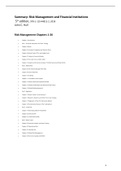Summary: Risk Management and Financial Institutions
5th edition, 978-1-119-44811-2, 2018
John C. Hull
Risk Management Chapters 1-26
• Chapter 1 Introduction
• Part 1: Financial Institutions and Their Trading
• Chapter 2 Banks
• Chapter 3 Insurance Companies and Pension Plans
• Chapter 4 Mutual Funds, ETFs, and Hedge Funds
• Chapter 5 Trading in Financial Markets
• Chapter 6 The Credit Crisis of 2007–2008
• Chapter 7 Valuation and Scenario Analysis: The Risk-Neutral and Real Worlds
• Part 2: Market Risk
• Chapter 8 How Traders Manage Their Risks
• Chapter 9 Interest Rate Risk
• Chapter 10 Volatility
• Chapter 11 Correlations and Copulas
• Chapter 12 Value at Risk and Expected Shortfall
• Chapter 13 Historical Simulation and Extreme Value Theory
• Chapter 14 Model-Building Approach
• Part 3: Regulation
• Chapter 15 Basel I, Basel II, and Solvency II
• Chapter 16 Basel II.5, Basel III, and Other Post-Crisis Changes
• Chapter 17 Regulation of the OTC Derivatives Market
• Chapter 18 Fundamental Review of the Trading Book
• Part 4: Credit Risk
• Chapter 19 Estimating Default Probabilities
• Chapter 20 CVA and DVA
• Chapter 21 Credit Value at Risk
• Part 5: Other Topics
• Chapter 22 Scenario Analysis and Stress Testing
• Chapter 23 Operational Risk
• Chapter 24 Liquidity Risk
• Chapter 25 Model Risk Management
• Chapter 26 Economic Capital and RAROC
1
,Chapter 1: Introduction
1.1 Risk vs Return for Investors
A convenient measure to quantify risk is the standard deviation of a return over one year:
When you combine two investments into a portfolio, the expected return is computed
below, where 1 is the expected return of the first investment and 2 of the second
investment.
μP=w1μ1+w2μ2
The portfolio standard deviation is given by the following equation:
The covariance is given by the following equation, where is the correlation coefficient.
Cov (r1,r2)=ρσ1σ2
1.2 The Efficient Frontier
In the figure on the left, the efficient frontier only consists of risky investments. If a risk-free
investment is included, the efficient frontier shifts to the line both touching the point of
tangency with the previous efficient frontier, and the y-intercept at RF. The equation for this
new efficient frontier is depicted below:
E (RI )=(1−βI ) RF +βI E(RM )
If we invest I in a risky investment and (1 – I) in a risk-free asset, the return would have a
standard deviation depicted below since the risk-free investment has zero standard deviation.
σ P=β I σM
2
, 1.3 The Capital Asset Pricing Model
The following formula shows a bet-fit linear relationship between returns from an investment
and returns from the market portfolio, where a and are constants, and is a
random variable equal to the regression error.
R=a+βRM+ϵ
This equation shows that there are two uncertain components: RM is systematic risk,
whereas is non-systematic risk.
In the Capital Asset Pricing Model (CAPM), the following equation expresses the expected
return of an investment.
E ( R)=RF+β[E (RM )−RF]
In this equation, beta is computed as follows:
ρσI
β= σ
M
The CAPM has a few assumptions:
1. Investors care only about expected return and standard deviation of their portfolio.
2. The variables for different investments are independent.
3. The investment horizon is the same for all investors.
4. Investors can borrow and lend at the risk-free rate.
5. There are no taxes.
6. Investors have homogeneous expectations.
1.4 Arbitrage Pricing Theory
Arbitrage Pricing Theory (APT) is an extension of the CAPM, where the expected return can
depend on several factors. The assumption that the variables for different investors are
independent in the CAPM equation ensures that there is just one factor driving expected
returns. This is the return on the market portfolio. In APT there are several factors affecting
3






